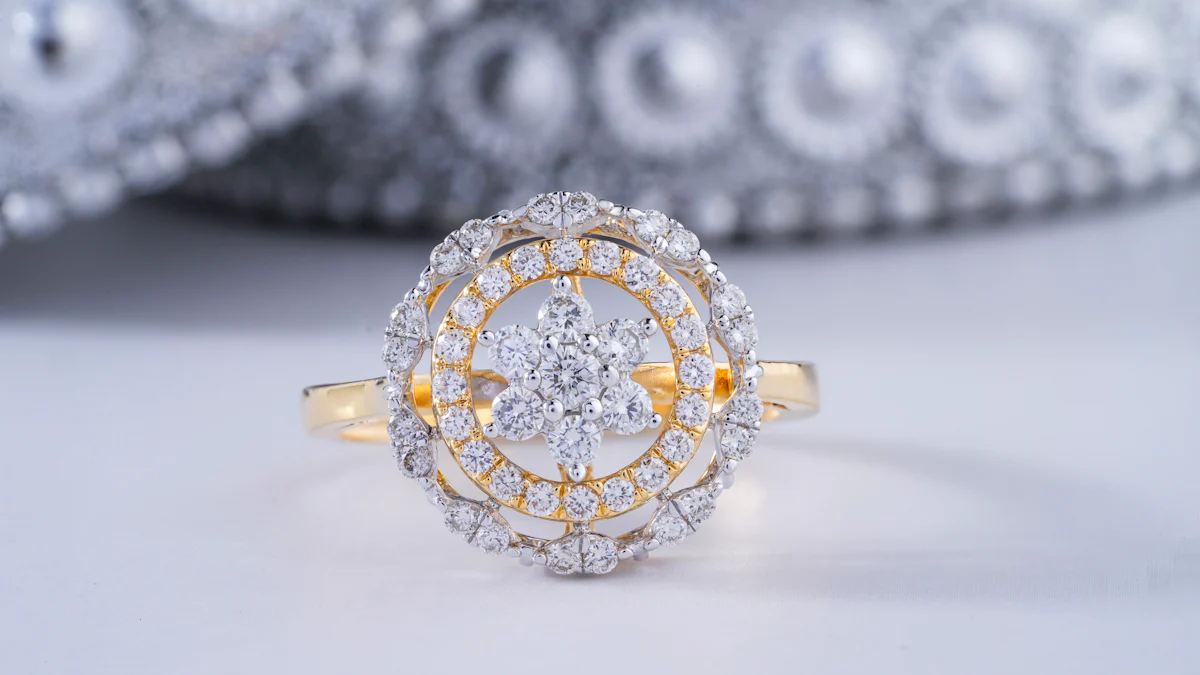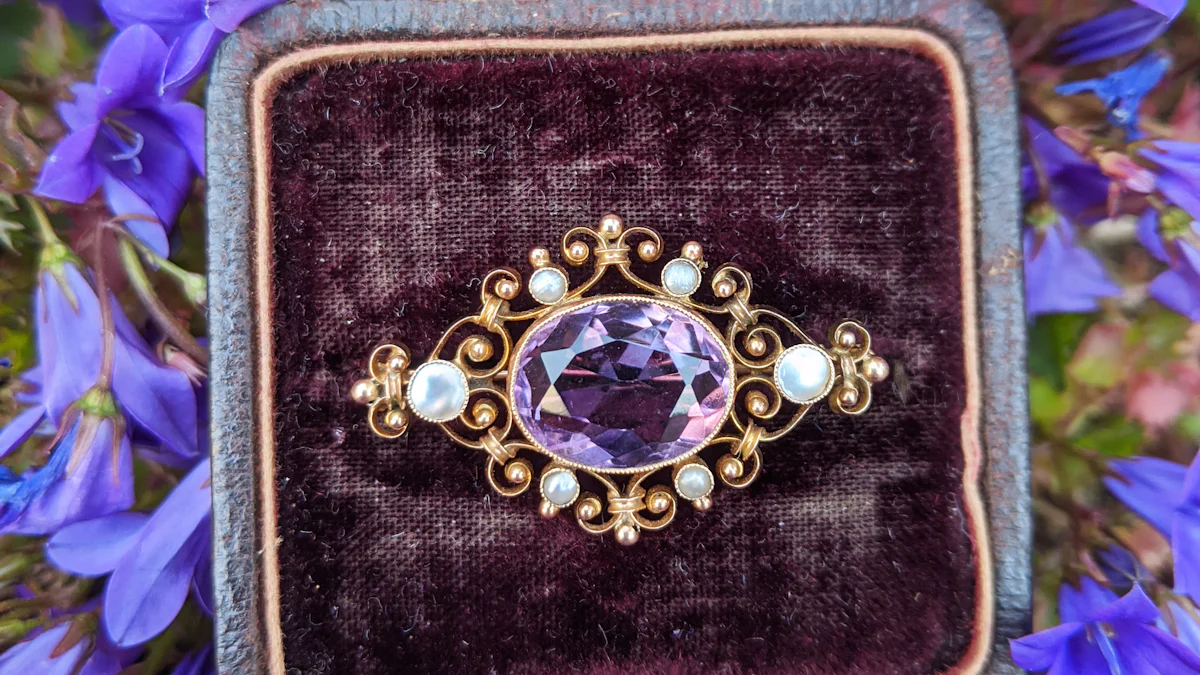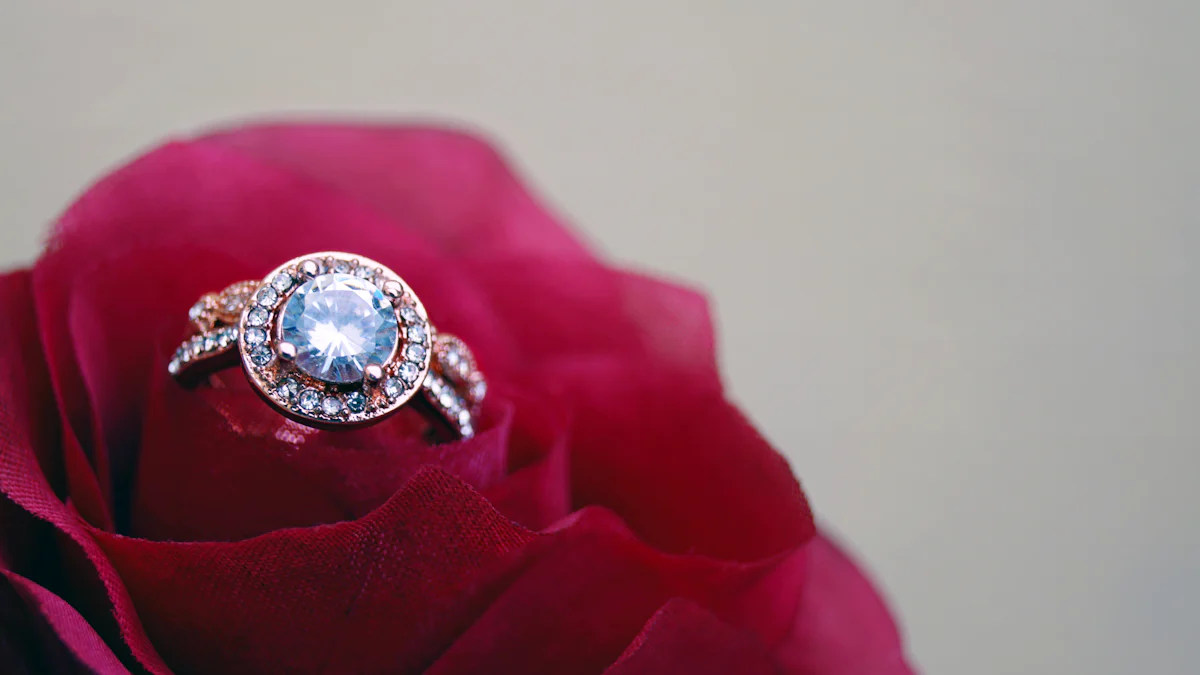Top 10 Vintage Diamond Cluster Rings for Collectors

The charm of a vintage diamond cluster ring lies in its ability to blend history with artistry. These rings, crafted with intricate designs, showcase the elegance of past eras. Collectors value them not only for their beauty but also for their investment potential. The global demand for vintage jewelry has surged, with online platforms making it easier to find unique pieces. Vintage diamond rings often feature elaborate details, such as floral motifs or geometric patterns, reflecting the craftsmanship of their time. Owning one adds a timeless piece of history to your collection.
Did you know? Famous vintage engagement rings, like Princess Diana’s sapphire and diamond ring, continue to inspire modern designs.
Victorian Era Vintage Diamond Cluster Rings

The Victorian era, spanning from 1837 to 1901, marked a golden age for jewelry design. Victorian diamond cluster rings became symbols of romance and elegance, often inspired by Queen Victoria's own love story. These rings reflected the era's fascination with intricate craftsmanship and meaningful motifs, making them a prized addition to any collection.
Old Mine Cut Diamond Cluster Ring
The old mine cut diamond cluster ring stands out as a quintessential piece of Victorian jewelry. This cut, known for its square shape with rounded corners, resembles today’s cushion-cut diamonds. You’ll notice its unique charm in the way it reflects light, creating a soft, romantic glow. Victorian jewelers often paired these diamonds with 18-carat yellow gold or silver, enhancing their timeless appeal.
The design of these rings emphasized delicate metalwork. Gems were set closer together, creating a seamless cluster that maximized brilliance. Techniques like repoussé and cannetille added intricate details to the band, showcasing the era’s dedication to artistry. Collectors value these rings not only for their beauty but also for their historical significance.
Floral Motif Diamond Cluster Ring
Floral motifs became a defining characteristic of Victorian cluster rings. These designs, inspired by nature, symbolized love, growth, and renewal. Diamonds arranged in petal-like patterns created a dazzling effect, while colored gemstones like sapphires, rubies, and emeralds added vibrant accents. Queen Victoria herself popularized this style, owning a serpent-shaped cluster ring that symbolized eternal love.
The floral motif diamond cluster ring often featured rose-cut diamonds, known for their domed tops and flat bases. This cut enhanced the natural beauty of the stones, giving them a soft, vintage glow. The use of lighter prongs and delicate settings further emphasized the elegance of these designs. Adding one of these rings to your collection allows you to own a piece of history that celebrates both nature and artistry.
Tip: Victorian cluster rings often include unique motifs like hearts, anchors, or even beetles. Look for these details to find a truly one-of-a-kind piece.
Edwardian Era Diamond Cluster Rings
The Edwardian era, spanning from 1901 to 1910, brought a new level of sophistication to jewelry design. This period introduced platinum as a preferred metal, revolutionizing the way diamond cluster rings were crafted. Platinum's strength and malleability allowed jewelers to create intricate designs that showcased both durability and elegance. Edwardian rings often featured delicate filigree work, emphasizing graceful lines and refined craftsmanship.
Platinum and Diamond Cluster Ring
Platinum and diamond cluster rings became iconic during the Edwardian era. The use of platinum enhanced the brilliance of diamonds, creating a striking contrast between the metal's cool tone and the gems' sparkle. This innovation marked a departure from the heavier Victorian styles, offering a lighter and more elegant aesthetic. You’ll notice how these rings often incorporate intricate details, such as lace-like patterns or milgrain edges, which highlight the era's dedication to artistry.
One remarkable example is an Edwardian halo cluster ring. It features a 0.20-carat old-cut diamond at its center, surrounded by a halo of ten old-cut diamonds totaling 1.20 carats. This design showcases the era's focus on symmetry and balance, making it a timeless addition to any collection. The introduction of innovative cuts, like the Asscher cut, further enhanced the natural beauty of diamonds, setting Edwardian rings apart from earlier styles.
Milgrain Diamond Cluster Ring
Milgrain detailing became a hallmark of Edwardian diamond cluster rings. This technique involves creating tiny bead-like patterns along the edges of the metal, adding texture and depth to the design. Milgrain work, combined with platinum's durability, allowed jewelers to craft rings that were both delicate and long-lasting. These features make Edwardian rings a favorite among collectors of vintage jewelry.
A stunning example of this craftsmanship is a sapphire and diamond cluster ring. It features twelve round diamonds weighing a total of 1.00 carat, surrounding a vibrant central gemstone. The milgrain detailing enhances the ring's overall elegance, making it a perfect representation of Edwardian artistry. Adding such a piece to your collection not only celebrates the era's innovation but also preserves its legacy.
Edwardian diamond cluster rings stand out for their refined elegance and intricate craftsmanship. Their designs reflect a shift towards luxury and sophistication, making them a prized choice for anyone seeking vintage diamond rings with historical significance.
Art Deco Vintage Diamond Cluster Rings

The Art Deco era, emerging in the 1920s, revolutionized jewelry design with its bold geometric patterns and modern aesthetic. This period celebrated symmetry, clean lines, and vibrant colors, making it a favorite among collectors of vintage jewelry. Art Deco vintage diamond cluster rings stand out for their intricate craftsmanship and striking visual appeal. These rings often feature platinum settings, which allow for delicate yet durable designs that complement the boldness of the era.
Geometric Diamond Cluster Ring
Geometric diamond cluster rings epitomize the Art Deco movement's fascination with structure and symmetry. These rings showcase diamonds arranged in precise geometric patterns, reflecting the influence of modern art movements like Cubism. Platinum settings enhance the brilliance of the diamonds while providing a sleek, contemporary look. The use of multiple smaller diamonds creates a bold visual impact, making these rings a statement piece in any collection.
Design elements such as step-cut diamonds, including emerald and baguette cuts, emphasize clean lines and geometric symmetry. Cluster settings, often paired with vibrant gemstones, add a pop of color and amplify the ring's vintage appeal. The intricate arrangements of diamonds and gemstones in these rings highlight the era's dedication to craftsmanship and artistry. Adding a geometric diamond cluster ring to your collection allows you to own a piece of history that celebrates the elegance of the Art Deco period.
Chevron Diamond Cluster Ring
Chevron diamond cluster rings offer a unique twist on the geometric designs of the Art Deco era. These rings feature a distinctive V-shaped pattern, symbolizing forward movement and modernity. The chevron design often incorporates a mix of diamonds and calibré-cut gemstones, creating a harmonious blend of sparkle and color. This combination enhances the ring's bold aesthetic while maintaining its vintage charm.
The chevron pattern's clean lines and symmetry reflect the Art Deco movement's admiration for structure and innovation. Platinum settings with milgrain detailing add texture and depth, elevating the ring's overall elegance. These rings often include invisible settings, where diamonds are placed flush against each other, creating a seamless surface of brilliance. A chevron diamond cluster ring is a perfect choice for those who appreciate the sophistication and artistry of vintage diamond rings.
Art Deco vintage diamond cluster rings remain a timeless choice for collectors. Their bold designs, intricate craftsmanship, and historical significance make them a valuable addition to any collection. Whether you prefer the structured beauty of a geometric ring or the dynamic elegance of a chevron design, these rings capture the spirit of an era that continues to inspire.
Retro Era Diamond Cluster Rings
The Retro era, spanning the 1940s and 1950s, brought bold and glamorous designs to the forefront of jewelry. This period reflected the optimism of post-war recovery, with jewelry styles becoming larger and more dramatic. Retro diamond cluster rings embraced this trend, showcasing innovative designs that combined elegance with a touch of extravagance.
Bombe Diamond Cluster Ring
The bombe diamond cluster ring stands out as a signature design of the Retro era. Its name comes from the French word "bombe," meaning "bomb," which describes the ring's domed or rounded shape. This design creates a striking three-dimensional effect, making it a true statement piece. You’ll often find these rings featuring a central cluster of diamonds surrounded by smaller stones, arranged in a way that maximizes brilliance.
Jewelers of the time used yellow and rose gold to craft these rings, adding warmth and richness to the design. The use of bold, rounded shapes reflected the era's fascination with modernity and innovation. Bombe rings often incorporated mixed cuts, such as baguette and round diamonds, to create a dynamic and eye-catching look. Adding one of these to your collection allows you to own a piece of vintage artistry that celebrates the bold spirit of the 1940s.
Ribbon Motif Diamond Cluster Ring
Ribbon motif diamond cluster rings capture the Retro era's love for playful and feminine designs. These rings mimic the appearance of flowing ribbons, often adorned with diamonds to enhance their sparkle. The ribbon motif symbolizes grace and elegance, making these rings a popular choice for special occasions.
Designers often paired diamonds with colored gemstones, such as rubies or sapphires, to add contrast and vibrancy. The use of asymmetrical patterns and curved lines in these rings reflects the influence of earlier movements like Art Nouveau, which celebrated organic forms. Platinum or gold settings provided durability while maintaining the luxurious feel of the design. A ribbon motif ring adds a touch of vintage charm to your collection, blending artistry with timeless elegance.
Fun Fact: The Retro era's bold jewelry designs were influenced by cultural events like the Art Nouveau movement and the Roaring Twenties, which introduced flowing lines and geometric shapes to jewelry.
Retro diamond cluster rings showcase the creativity and resilience of their time. Their bold designs and intricate craftsmanship make them a must-have for anyone passionate about vintage diamond rings.
Mid-Century Vintage Diamond Cluster Rings
The Mid-Century era, spanning the 1940s to the 1960s, introduced a fascinating evolution in jewelry design. Diamond cluster rings from this period reflected the optimism of post-war recovery, blending classic elegance with modern innovation. These rings became a symbol of luxury and individuality, making them a favorite among collectors today.
Starburst Diamond Cluster Ring
The starburst diamond cluster ring captures the essence of Mid-Century design. Its unique arrangement of diamonds radiates outward, mimicking the appearance of a starburst. This design symbolizes brilliance and energy, making it a striking addition to any collection. Jewelers often paired diamonds with colorful gemstones like sapphires or rubies, adding a vibrant touch to the design.
The use of yellow and white gold dominated this era, though platinum also appeared in many rings. Designers like Harry Winston and Tiffany popularized the starburst motif, showcasing their creativity and craftsmanship. These rings often featured minimalist bands, allowing the intricate cluster to take center stage. Adding a starburst ring to your collection lets you celebrate the bold spirit of the 1950s and 1960s.
Note: Starburst designs reflect the influence of modern art movements, emphasizing symmetry and bold aesthetics.
Halo Diamond Cluster Ring
The halo diamond cluster ring became another iconic design of the Mid-Century era. This style features a central diamond surrounded by a "halo" of smaller diamonds, creating a dazzling effect. The halo design enhances the size and brilliance of the central stone, making it a popular choice for those seeking a glamorous look.
Mid-Century halo rings often incorporated colorful gemstones alongside diamonds, reflecting the era's love for individuality. The minimalist settings of this period replaced the intricate metalwork of earlier decades, offering a sleek and modern aesthetic. Yellow and white gold remained the preferred metals, though platinum added a touch of sophistication to many designs.
Tip: Look for halo rings from renowned designers like Bulgari or Tiffany to add a piece of history to your collection.
Design Highlights of Mid-Century Rings
| Design Element | Description | |---------------------------|-------------------------------------------------------------------------------------------------| | Evolution of Styles | Transition from classic, feminine designs to streamlined and colorful aesthetics. | | Use of Gemstones | Diamonds paired with colorful gemstones for added sparkle and elaborate designs. | | Choice of Metals | Predominantly yellow and white gold, with platinum also featured in many rings. | | Design Trends | Shift from intricate metalwork to minimalist bands and settings. | | Influence of Designers | Contributions from renowned designers like Bulgari, Tiffany, and Harry Winston. |
The Mid-Century era brought a fresh perspective to vintage diamond cluster rings. Its designs combined timeless elegance with modern trends, making these rings a valuable addition to any collection. Whether you prefer the radiant starburst or the glamorous halo, these rings offer a glimpse into a transformative period in jewelry history.
Vintage diamond cluster rings hold a timeless appeal that transcends fleeting trends. These rings combine historical significance with artistic value, offering you a glimpse into the craftsmanship of past eras. From the intricate floral motifs of the Victorian period to the bold geometric designs of Art Deco, each ring tells a unique story. Their enduring charm lies in their ability to symbolize love, unity, and commitment while serving as valuable investments.
When you invest in a vintage diamond ring, you gain more than a piece of jewelry. You acquire a piece of history that appreciates in value over time. Consider the Four Cs—cut, color, clarity, and carat weight—when selecting your ring to ensure its quality and brilliance. Exploring these rings allows you to celebrate artistry and preserve the legacy of timeless design.
Tip: Look for unique details like milgrain edges or gemstone accents to find a truly one-of-a-kind vintage ring.
FAQ
What makes a vintage diamond ring unique?
A vintage diamond ring stands out due to its historical significance and intricate craftsmanship. These rings often feature unique designs, such as floral motifs or geometric patterns, that reflect the artistry of their era. Owning one connects you to a piece of history.
How can you identify an authentic vintage diamond ring?
Look for hallmarks or stamps indicating the metal type and era. Examine the craftsmanship and design details. Consulting a certified gemologist or appraiser ensures authenticity. Vintage rings often showcase older diamond cuts like rose or old mine cuts.
Are vintage diamond rings a good investment?
Yes, vintage diamond rings hold their value and often appreciate over time. Their rarity and historical significance make them desirable among collectors. Choosing a well-preserved piece with unique features enhances its investment potential.
How should you care for a vintage diamond ring?
Clean your ring gently using a soft brush and mild soap. Avoid harsh chemicals or ultrasonic cleaners, as they may damage delicate settings. Store it in a padded box to prevent scratches. Regular professional inspections ensure its longevity.
Where can you buy vintage diamond rings?
You can find vintage diamond rings at antique jewelry stores, estate sales, and reputable online platforms. Ensure the seller provides certification or documentation verifying the ring's authenticity and quality.
See Also
10 Exquisite Diamond Bands Ideal for Engagements
15 Gorgeous Ruby and Diamond Rings for Any Occasion
15 Distinctive Engagement Rings Without Diamonds to Explore

